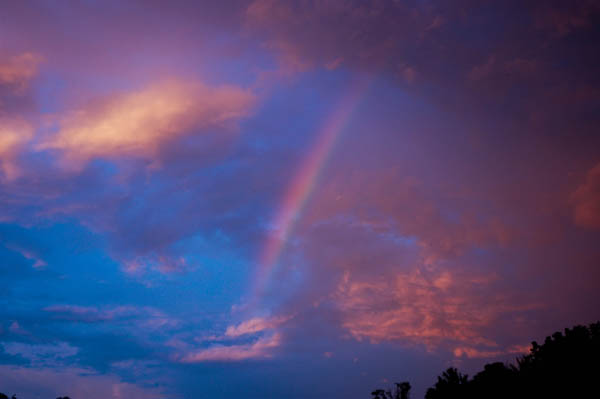
A rainbow is an optical and meteorological phenomenon that causes a spectrum of light to appear in the sky when the Sun shines onto droplets of moisture in the Earth’s atmosphere. They take the form of a multicolouredarc, with red on the outer part of the arch and violet on the inner section of the arch.
A rainbow spans a continuous spectrum of colours. Traditionally, however, the sequence is quantised. The most commonly cited and remembered sequence, in English, is Newton’s sevenfold red, orange, yellow, green, blue, indigo and violet. “Roy G. Biv” and “Richard Of York Gave/Gained Battle In Vain” are popular mnemonics. Another one is “Read Out Your Green Book In Verse”.
Visibility
Rainbows can be observed whenever there are water drops in the air and sunlight shining from behind a person at a low altitude angle (on the ground). The most spectacular rainbow displays happen when half of the sky is still dark with raining clouds and the observer is at a spot with clear sky in the direction of the Sun. The result is a luminous rainbow that contrasts with the darkened background.
The rainbow effect is also commonly seen near waterfalls or fountains. The effect can also be artificially created by dispersing water droplets into the air during a sunny day. Rarely, a moonbow, lunar rainbow or nighttime rainbow, can be seen on strongly moonlit nights. As human visual perception for colour is poor in low light, moonbows are often perceived to be white.[1] It is difficult to photograph the complete semi-circle of a rainbow in one frame, as this would require an angle of view of 84°. For a 35 mm camera, a lens with a focal length of 19 mm or less wide-angle lens would be required. Now that powerful software for stitching several images into a panorama is available, images of the entire arc and even secondary arcs can be created fairly easily from a series of overlapping frames. From an aeroplane, one has the opportunity to see the whole circle of the rainbow, with the plane’s shadow in the centre. This phenomenon can be confused with the glory, but a glory is usually much smaller, covering only 5°–20°.
Scientific explanation
The light is first refracted as it enters the surface of the raindrop, reflected off the back of the drop, and again refracted as it leaves the drop. The overall effect is that the incoming light is reflected back over a wide range of angles, with the most intense light at an angle of 40°–42°. The angle is independent of the size of the drop, but does depend on its refractive index. Seawater has a higher refractive index than rain water, so the radius of a ‘rainbow’ in sea spray is smaller than a true rainbow. This is visible to the naked eye by a misalignment of these bows.[2] The amount by which light is refracted depends upon its wavelength, and hence its colour. Blue light (shorter wavelength) is refracted at a greater angle than red light, but due to the reflection of light rays from the back of the droplet, the blue light emerges from the droplet at a smaller angle to the original incident white light ray than the red light. You may then think it is strange that the pattern of colours in a rainbow has red on the outside of the arc and blue on the inside. However, when we examine this issue more closely, we realise that if the red light from one droplet is seen by an observer, then the blue light from that droplet will not be seen because it must be on a different path from the red light: a path which is not incident with the observer’s eyes. The blue light seen in this rainbow will therefore come from a different droplet, which must be below that whose red light can be observed.
Contrary to popular belief, the light at the back of the raindrop does not undergo total internal reflection, and some light does emerge from the back. However, light coming out the back of the raindrop does not create a rainbow between the observer and the sun because spectra emitted from the back of the raindrop do not have a maximum of intensity, as the other visible rainbows do, and thus the colours blend together rather than forming a rainbow.










0 comments:
Post a Comment